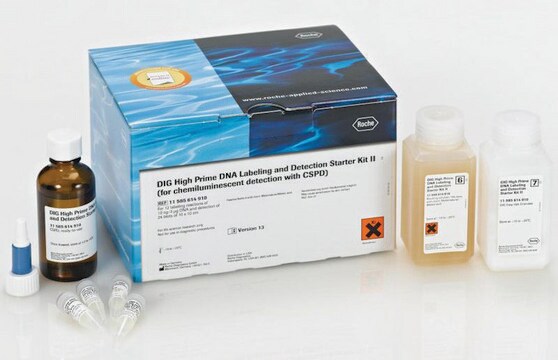11745832910
Roche
DIG-High Prime DNA Labeling and Detection Starter Kit I
sufficient for 12 labeling reactions, sufficient for 24 blots, suitable for hybridization, suitable for Northern blotting, suitable for Southern blotting
Sinónimos:
DIG system, dna labeling
About This Item
Productos recomendados
uso
sufficient for 12 labeling reactions
sufficient for 24 blots
Nivel de calidad
envase
kit of 1 (7 components)
fabricante / nombre comercial
Roche
características de los productos alternativos más sostenibles
Designing Safer Chemicals
Learn more about the Principles of Green Chemistry.
sustainability
Greener Alternative Product
técnicas
Northern blotting: suitable
Southern blotting: suitable
hybridization: suitable
categoría alternativa más sostenible
, Aligned
temp. de almacenamiento
−20°C
Descripción general
Aplicación
- in Southern blots
- in northern blots
- in dot blots
- in colony and plaque hybridizations
- for all types of filter hybridization
- for single-copy gene detection in total genomic DNA, even from organisms with high complexity, for example, human, barley and wheat
Características y beneficios
Envase
Calidad
Otras notas
Solo componentes del kit
- DIG-High Prime 5x concentrated
- DIG-labeled Control DNA, pBR328 (linearized with Bam HI) 5 μg/ml
- DNA Dilution Buffer
- Anti-Digoxigenin-AP Conjugate antibody
- NBT/BCIP Stock Solution, concentrated
- Blocking Solution 10x concentrated
- DIG Easy Hyb Granules
Palabra de señalización
Warning
Frases de peligro
Consejos de prudencia
Clasificaciones de peligro
Eye Irrit. 2 - Skin Irrit. 2
Código de clase de almacenamiento
12 - Non Combustible Liquids
Clase de riesgo para el agua (WGK)
WGK 3
Punto de inflamabilidad (°F)
does not flash
Punto de inflamabilidad (°C)
does not flash
Certificados de análisis (COA)
Busque Certificados de análisis (COA) introduciendo el número de lote del producto. Los números de lote se encuentran en la etiqueta del producto después de las palabras «Lot» o «Batch»
¿Ya tiene este producto?
Encuentre la documentación para los productos que ha comprado recientemente en la Biblioteca de documentos.
Los clientes también vieron
Artículos
Digoxigenin (DIG) labeling methods and kits for DNA and RNA DIG probes, random primed DNA labeling, nick translation labeling, 5’ and 3’ oligonucleotide end-labeling.
Nuestro equipo de científicos tiene experiencia en todas las áreas de investigación: Ciencias de la vida, Ciencia de los materiales, Síntesis química, Cromatografía, Analítica y muchas otras.
Póngase en contacto con el Servicio técnico






